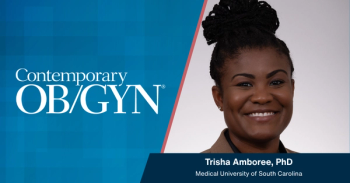
- Vol 66 No 6
- Volume 66
- Issue 06
ACOG 2021: Beyond the Pandemic
Significant updates occurred in women’s health issues while the world was in survival mode.
Contemporary OB/GYN® Senior Editor Angie DeRosa compiled the following report based on a presentation at the 2021 American College of Obstetricians and Gynecologists (ACOG) Annual Clinical and Scientific Meeting (ACSM) by Editorial Board member Christine R. Isaacs, MD; and William M. Leininger, MD.
Isaacs and Leininger presented the Kathryn M. and Thomas F. Purdon, MD, Generalists Session “While You Were Slee(PPE)ing: Women’s Health Updates Beyond the Pandemic’s Priorities” on May 2, the final day of the conference. It was a joint session of ACOG and the Society of Academic Specialists in General Obstetrics and Gynecology (SASGOG).
Isaacs and Leininger provided ACOG ACSM attendees with a high-level overview on clinically valuable updates that may have been pushed to the back burner as COVID-19–related medical care dominated 2020.1
Isaacs is an ob/gyn, a professor, academic specialist division chief, and medical director of midwifery services at the Virginia Commonwealth University School of Medicine in Richmond. Leininger is an ob/gyn at Naval Medical Center San Diego in California. He is an assistant professor of ob/gyn at the Uniformed Services University of Health Sciences in Bethesda, Maryland.
The actionable, direct patient care updates discussed by Isaacs and Leininger were published from late 2019 through 2020. However, during that time frame, many practice-based learning activities understandably focused on pandemic changes, and clinical practice was overwhelmed with pandemic adaptation and response activities.
Their presentation identified high-value actionable updates for the generalist ob/gyn based on importance to one’s general clinical practice. Out of respect for content covered in other venues, they purposely chose focuses not related to COVID-19; diversity, equity, and inclusion; policy; and content identified in ACOG Practice Bulletins, Committee Opinions, Choose Wisely, or in the Consult Series from the Society for Maternal-Fetal Medicine (SMFM) all of which can be easily accessed by ACOG members. Isaacs and Leininger selected 30 articles of high value and interest that were screened based on title and abstract from multiple journals and health care organizations.
The SASGOG board of directors reviewed and reprioritized the list to cover high volume and high consequence conditions. Isaacs and Leininger then selected the top 14 and summarized each. “The SASGOG Board of Directors ultimately selected these articles to cover both high volume and high consequence conditions,” Leininger said.
Gonococcal Infection Treatment Guidelines
The first topic involved updated guidelines from the Centers for Disease Control and Prevention (CDC) for uncomplicated cases of gonococcal infection.2 The guidelines recommend single-agent treatment with ceftriaxone based on a person’s weight (500 mg intramuscular (IM) as a single dose for patients weighing 150 kg/~300 lb or less and 1 g intramuscularly for persons weighing 150kg/~300 lb or more. These changes reflect the low incidence of ceftriaxone resistance and continued efforts at antimicrobial stewardship. The updated guidelines state that if chlamydia infection has not been excluded, providers should treat for such with doxycycline 100 mg orally twice per day for 7 days in a nonpregnant state or with azithromycin 1 g as a single dose during pregnancy.
The CDC has an app, STD Treatment (Tx) Guide, that can be downloaded from Apple’s App store or Google Play with the current updated guidelines.
Hepatitis C Screening
For hepatitis C virus infection in adolescents and adults, the US Preventive Services Task Force now recommends screening for all including pregnant and nonpregnant individuals.3 There is no vaccine, nor is pre- or postexposure prophylaxis available. The virus spreads primarily through parenteral exposure, blood, body fluids with blood, and injection drug use. The suggested practice change is to include hepatitis C antibody screening in new obstetric lab panels as this is often the first opportunity for patients to initiate health care and screening.
Treating Couples with Unexplained Infertility
In February 2020, the American Society for Reproductive Medicine published new practice guidelines for couples with unexplained infertility.4 These recommendations detail the evidence for various regimens using oral ovulation inducing medicines, gonadotropins, and intrauterine insemination (IUI) that have demonstrated little benefit for improving pregnancy rates or have a higher incidence of multiple gestations. Couples should start with 3 or 4 cycles of ovarian stimulation with oral agents and IUI. If that strategy is unsuccessful, then proceed to in vitro fertilization.
Umbilical Cord Milking vs DelayedUmbilical Cord Clamping
Isaacs and Leininger then moved on to an article that compared the risk of umbilical cord milking vs delayed umbilical cord clamping causing death or severe intraventricular hemorrhage (IVH) among preterm infants. The study was published in November 2019 in the Journal of the American Medical Association.5 It included 474 preterm infants (23+0 to 31+6 weeks gestational age [wGA]). An increased risk for severe IVH was found with umbilical cord milking, especially in 23+0 to 27+6 wGA (P = .002), they said. The practice implication is to prioritize delayed cord clamping over umbilical cord milking for placental transfusion at delivery of 23+0 to 27+6 wGA.
Cervical Cancer Screening
A major paradigm shift occurred following the American Society for Colposcopy and Cervical Pathology (ASCCP) updated guidelines for cervical cancer screening, Isaacs said. They moved it from relying on test results for algorithms to making it risk-based, she added.
“The algorithms take into effect patients’ screening history,” Isaacs said. “Newer HPV infections are not as concerning as those that have existed and persisted.”
In addition, the American Cancer Society released recommendations in 2020 that endorsed and preferred primary HPV testing beginning at age 25. Then, in April 2021, ACOG released its practice advisory stating that screening should begin at age 21.
“We do not want to delay screening efforts,” Isaacs said. She added that for women of average risk, primary HPV screening is an option but not the only screening option. An updated app from ASCCP offers a tool for practicing ob/gyns to guide decision-making.
Withdrawing Approval of Makena
In October 2020, the Food and Drug Administration shared a summary of their deliberations to propose withdrawing approval of Makena, a drug that was approved for the prevention of recurrent preterm birth.6 Initial approval was accelerated because of the reduction in recurrent preterm birth. However, there was insufficient evidence at that time to evaluate newborn benefit.
A subsequent study failed to find either newborn benefit or prolongation of pregnancy. Although a final decision on the proposal was still pending as of May 2, the date of Isaacs’ and Leininger’s presentation, clinicians will need to individualize complex issues for patients who are at risk of recurrent preterm delivery based on logistics, cost, utility, and expectation management. The experts recommended seeing recent releases from ACOG and SMFM on the meta-analysis from Evaluating Progestogens for Preventing Preterm Birth International Collaborative.
Levonorgestrel vs Copper IUD for Emergency Contraception
Next, Isaacs and Leininger covered a study that compared the use of levonorgestrel vs copper intrauterine devices (IUD) for emergency contraception. In January 2021, the New England Journal of Medicine published “Levonorgestrel vs Copper Intrauterine Devices for Emergency Contraception,”7 which involved 711 participants who were randomly assigned in a 1:1 ratio to receive a levonorgestrel 52-mg IUD or a copper T380A IUD for emergency contraception, with a 1-month follow up to assess for pregnancy. In the modified intention-to-treat and per-protocol analyses, pregnancy rates were 1 in 317 (0.3%; 95% CI, 0.01-1.7) in the levonorgestrel group and 0 in 321 (0%; 95% CI, 0-1.1) in the copper IUD group, indicating that the levonorgestrel IUD was noninferior to the copper IUD for emergency contraception.
The study holds promise for future emergency contraception options and shared decision-making for patients.
Mifepristone Combination Therapy Compared with Misoprostol Monotherapy
Another important finding covered by Isaacs and Leininger involved a cost-benefit analysis of mifepristone plus misoprostol compared with misoprostol alone for the treatment of miscarriage. For their study published in Obstetrics & Gynecology in October 2020,8 investigators used decision tree analyses and Monte Carlo simulations covering variables such as medication costs, treatment success rates, need for surgery, and patient time away from work. Based on the parameters used, the analysis results showed that combination therapy was consistently more cost-effective than monotherapy.
Axillary Adenopathy in Patients with Recent COVID-19 Vaccination
Recommendations also now exist for the management of axillary adenopathy in patients with recent COVID-19 vaccination from the Society for Breast Imaging.9 In normal screening mammograms, axillary adenopathy reports are 0.2% to 0.4%, which is rare, Isaacs and Leininger said. Lymphadenopathy as an unsolicited adverse event in vaccine trials was 1.1% based on clinical assessment. The true incidence is likely higher, they explained. The related practice change is the recommendation that breast screening imaging be performed prior to vaccination when possible. If mammographic screening is required after vaccination, consider postponing screening for at least 4 to 6 weeks after the final vaccination dose to avoid false-positive results. If a clinical breast concern exists, imaging should ensue without delay.
Early-onset Breast Cancer Detection
The presenters then addressed early-onset breast cancer—cases diagnosed in patients between ages 18 and 45 years—detection by discussing the CDC’s Bring Your Brave campaign, which shares patient stories and provides information for women affected by the disease, such as gaps and disparities in cancer diagnosis, treatment, and outcomes.10
Providers can take an evidence-based continuing medical education (CME)–accredited online course that reviews key concepts for early-onset breast cancer detection and/or reference “Executive Summary of the Early-Onset Breast Cancer Evidence Review Conference,” published in Obstetrics & Gynecology in June 2020.11 The series will continue with future topics (uterine, ovarian, vaginal, vulvar, and anal cancers), Isaacs explained, and she encouraged attendees to take the free CME course, offered through ACOG at acog.org.
Intrapartum Oxygen Supplementation Effects on Category II Fetal Monitoring
In a randomized controlled trial, published in the June 2020 issue of the American Journal of Obstetrics and Gynecology, investigators studied 114 term laboring patients randomized to room air versus 10L of oxygen per minute by face mask for Category II tracing.12 After 60 minutes, fetal heart tones were evaluated for recurrent/late variable decelerations, prolonged decelerations, tachycardia, and minimal variability, the presenters said. Investigators found that hyperoxia treatment does not appear to improve a Category II tracing. Therefore, based on this study and similar ones, clinicians should not delay other interventions while using oxygen supplementation for fetal in utero resuscitation, Leininger said.
Indicators of Early Menopause Following Opportunistic Salpingectomy
A cohort study from British Columbia, Canada, examined indicators of early menopause following opportunistic salpingectomy (OS).13 Investigators identified all women (41,413) who were 50 years or younger at the time of surgery who underwent OS from 2008 to 2014. For this cohort, they defined menopause onset as the age at the first visit for menopause symptoms or the first prescription for hormone therapy. They then allocated the patients by the following surgery types: hysterectomy alone, hysterectomy with OS, hysterectomy with bilateral salpingo-oophorectomy (BSO), tubal ligation, and OS for sterilization. Based on the study’s definition of menopause onset, only the women who underwent hysterectomy with BSO had an earlier age of onset of menopause compared with the other groups. These findings should help surgeons counsel patients about OS as a treatment option, according to Isaacs and Leininger.
Vaginal Prep with Antiseptic Solution Before Cesarean for Preventing Postoperative Infections
Isaacs and Leininger reviewed the Cochrane Library publication, which examined if vaginal preparations with antiseptic solutions done before cesarean delivery were effective in preventing postoperative infections such as endometritis and wound complications.14 The 21 trials that included 7038 women across 10 countries, Isaacs said. The antiseptics used were iodine-based or chlorhexidine solutions, as compared with saline or no vaginal cleansing. The results showed that use of vaginal antiseptic solutions probably did reduce the number of postoperative endometritis infections, wound infections, and fevers. The speakers concluded that this practice is a simple yet important intervention can have great benefit when incorporated into surgical checklists.
Updated Maternity Care Standards
The Joint Commission released updated maternity care standards for hypertension and hemorrhage effective January 1, 2021.15 It expands requirements for patient assessments, unit protocols and processes for patient management, equipment and supply access, recurring education and simulation drills, case reviews, and patient education. Based on discussions with other organizations and personal experience, the presenters said obstetric practices will need to pursue sustained, iterative, multidisciplinary effort over several months to fulfill these requirements.
Disclosures
The views expressed by William Leininger, MD, are his own and do not reflect the official policy or position of the Department of the Navy, Department of Defense, nor the US government.
References
- Isaacs C and Leininger WM. The Kathryn M. and Thomas F. Purdon, MD, Generalists Session: While you were Slee(PPE)ing: women’s wealth updates beyond the pandemic’s priorities. Presented at: Virtual Meeting of the American College of Obstetricians and Gynecologists 2021 Annual Clinical and Scientific Meeting; May 2, 2021.
acog.org/education-and-events/meetings/acog-annual-clinical-and-scientific-meeting - St Cyr S, Barbee L, Workowski KA, et al. Update to CDC’s treatment guidelines for gonococcal infection, 2020. MMWR Morb Mortal Wkly Rep. 2020;69(50):1911-1916. doi:10.15585/mmwr.mm6950a6
- Owens DK, Davidson KW et al; US Preventive Services Task Force. Screening for Hepatitis C virus infection in adolescents and adults:
- US Preventive Services Task Force recommendation statement.
- JAMA. 2020;323(10):970-975. doi:10.1001/jama.2020.1123
- Practice Committee of the American Society for Reproductive Medicine. Evidence-based treatments for couples with unexplained infertility: a guideline.
- Fertil Steril. 2020;113(2):305-322. doi:10.1016/j.fertnstert.2019.10.014
- Katheria A, Reister F, Essers J, et al. Association of umbilical cord milking vs delayed umbilical cord clamping with death or severe intraventricular hemorrhage among preterm infants. JAMA. 2019;322(19):1877-1886. doi:10.1001/jama.2019.16004
- Chang CY, Nguyen CP, Wesley B, Guo J, Johnson LL, Joffe HV. Withdrawing approval of Makena — a proposal from the FDA Center for Drug Evaluation and Research. N Engl J Med. 2020;383(24):e131. doi:10.1056/NEJMp2031055
- Turok DK, Gero A, Simmons RG, et al. Levonorgestrel vs. copper intrauterine devices for emergency contraception. N Engl J Med. 2021;384(4):335-344. doi:10.1056/NEJMoa2022141
- Berkley HH, Greene HL, Wittenberger MD. Mifepristone combination therapy compared with Misoprostol monotherapy for the management of miscarriage: a cost-effectiveness analysis. Obstet Gynecol. 2020;136(4):774-781. doi:10.1097/AOG.0000000000004063
- SBI recommendations for the management of axillary adenopathy in patients with recent COVID-19 vaccination. Society of Breast Imaging. March 9, 2021. Accessed May 11, 2021.
sbi-online.org/Portals/0/Position%20Statements/2021/SBI-recommendations-for-managing-axillary-adenopathy-post-COVID-vaccination.pdf - Bring Your Brave Campaign. Centers for Disease Control and Prevention. Accessed May 11, 2021.
cdc.gov/cancer/breast/young_women/bringyourbrave/about.htm - Chelmow D, Pearlman MD, Young A, et al. Executive summary of the early-onset breast cancer evidence review conference. Obstet Gynecol. 2020;135(6):1457-1478. doi:10.1097/AOG.0000000000003889
- Raghuraman N, López JD, Carter EB, et al. The effect of intrapartum oxygen supplementation on category II fetal monitoring. Am J Obstet Gynecol. 2020; 223(6):905.e1-905.e7. doi:10.1016/j.ajog.2020.06.037
- Hanley GE, Kwon JS, McAlpine JN, Huntsman DG, Finlayson SJ, Miller D. Examining indicators of early menopause following opportunistic salpingectomy: a cohort study from British Columbia, Canada. Am J Obstet Gynecol. 2020;223(2):221.e1-221.e11. doi: 10.1016/j.ajog.2020.02.005
- Haas DM, Morgan S, Contreras K, Enders S. Vaginal preparation with antiseptic solution before cesarean section for preventing postoperative infections. Cochrane Database Syst Rev. 2018;(7):CD007892. doi:10.1002/14651858.CD007892.pub6
- Updated Maternity Care Standards re: HTN and HemorrhageTJC – R3 Report: Requirement, Rationale, Reference; August 19, 2019. Accessed May 11, 2021.
https://www.jointcommission.org/standards/r3-report/r3-report-issue-24-pc-standards-for-maternal-safety/
Articles in this issue
over 4 years ago
Beyond the Pandemic: Articles and Resources for Self-Educationover 4 years ago
Acute Fatty Liver of Pregnancyover 4 years ago
New Mother's Thumbover 4 years ago
What's New in Women's Health?over 4 years ago
Moving Beyond Checking the Boxover 4 years ago
US Women’s Sexual and Reproductive Health Trendsover 4 years ago
Genetic factors for reproductive aging and vasomotor symptomsNewsletter
Get the latest clinical updates, case studies, and expert commentary in obstetric and gynecologic care. Sign up now to stay informed.




















